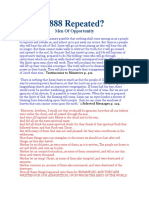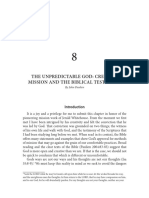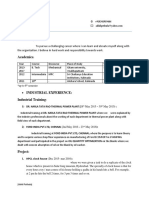A Brief Summary of The 1888 Message
A Brief Summary of The 1888 Message
Uploaded by
Robert BargayoCopyright:
Available Formats
A Brief Summary of The 1888 Message
A Brief Summary of The 1888 Message
Uploaded by
Robert BargayoOriginal Title
Copyright
Available Formats
Share this document
Did you find this document useful?
Is this content inappropriate?
Copyright:
Available Formats
A Brief Summary of The 1888 Message
A Brief Summary of The 1888 Message
Uploaded by
Robert BargayoCopyright:
Available Formats
A Brief Summary of the 1888 Message
A Brief Summary of the
1888 Message
A Short History
At the General conference Session held in 1888 in Minneapolis, Minnesota, two young
men, Alonzo T. Jones and Ellet J. Waggoner, providentially conveyed to the delegates a
beautiful message of justification by faith that became controversial because some
opposed it. Many of the delegates, especially the older ministers and leaders, made the
message (and the messengers) unwelcome.
A few rejoiced and truly accepted the message. Foremost among them was a lady
sitting in the front row, Ellen G. White. No official person seems to have thought the
message important enough to take it down in shorthand and transcribe it so that
posterity could know firsthand what they said at that meeting. Hence, we do not have
the “1888 message” itself in the exact words of the two young “messengers.”
But this does not mean that we have no understanding of what the message was.
Certain facts make it possible for us to reconstruct a fair and accurate concept of what
they taught.
For example, we know from his writings what Waggoner taught in the months
immediately before the 1888 General Conference, and we know what he taught in the
weeks immediately after. We also have his book, The Gospel in Galatians, which he
presented to the conference delegates. It articulates the message he believed regarding
the gospel of justification by faith and particularly the nature of Christ and the two
covenants.
We know that Waggoner and Jones were in perfect agreement in their understanding of
righteousness by faith both at Minneapolis and for about a decade after 1888. There
were two messengers, but Ellen White spoke repeatedly of what they brought us as
being one “message.” She continued to endorse their ongoing presentations for years
after the 1888 General Conference.
Ellen White saw that the 1888 message was “the third angel’s message in verity,” “new
light,” “a message which is present truth for this time,” “light from heaven,” “the light
which is to lighten the earth with its glory.” It was not only that Jesus pardons sin; He
saves from its power and slavery even now.
The following ten “points” summarize the core of the 1888 message. We hope this will
aid in your study of Sabbath School Today.
—The Sabbath School Today Authors
www.1888mpm.org Sabbath School Today | Extra 1
A Brief Summary of the 1888 Message
What Did the Message Say?
1. Christ has already accomplished something for every human being. He died
the “second death” for “every man,” and thus has elected all men to be saved. But we
have freedom to refuse and despise as Esau despised his birthright. In that judicial
sense, Christ is indeed “the Savior of the world.” When lukewarm Laodiceans
appreciate what He has already accomplished for the world, they will better understand
faith, and how to glory only in the cross.
2. By His uplifted cross and His on-going priestly ministry, Christ is drawing “all
men” to repentance. His love is so strong and persistent that the sinner must resist it
in order to be lost.
3. It follows that it is easy to be saved and hard to be lost if one understands and
believes how good the Good News is. The only difficult thing is learning how to believe
the Good News. Jesus emphasized this truth.
4. Christ is the Good Shepherd who is not waiting for the lost sheep to find Him,
but He is actively seeking it. A misunderstanding of God’s character causes us to
think He is hiding from us, or is indifferent to us. There is no parable of a lost sheep that
must find its shepherd.
5. In seeking us, Christ came all the way to where we are, taking upon Himself “the
likeness of sinful flesh, and for sin, condemned sin in the flesh.” Thus He is a Savior
“nigh at hand, and not afar off.” He is already the “the Savior of all men,” even the “chief
of sinners.” But sinners have the freedom to refuse Him, and reject Him.
6. The New Covenant is God’s one-way promise to write His law in our hearts,
and to give us everlasting salvation as a free gift “in Christ.” The Old Covenant is the
vain promise of the people to obey, and it “gives birth to bondage.” The spiritual failures
of many sincere people are the result of being taught Old Covenant ideas, especially in
childhood and youth. The New Covenant truth is an essential element of the 1888
message, and even today lifts a load of doubt and despair from many heavy hearts.
7. Our Savior “condemned sin in the flesh,” conquering the problem for the
human race. He forever outlawed sin in the vast universe of God by defeating it in its
last lair—our fallen, sinful human flesh and nature. Because of Him there is now no
reason for any of us to go on living under the frightful “dominion” of sin. Sinful addictions
lose their grip if one cherishes “the faith of Jesus.”
8. A higher motivation becomes realized in the close of time than has prevailed in
the church in all past ages—a concern for Christ that He receive His reward and find His
“rest” in the final eradication of sin. All egocentric motivation based on fear of hell or
hope of reward is Old Covenant in nature and is less effective. The higher motivation is
symbolized in the climax of Scripture—the Bride of Christ making herself “ready” for the
“marriage of the Lamb.”
www.1888mpm.org Sabbath School Today | Extra 2
A Brief Summary of the 1888 Message
9. The Bible teaches that righteousness is by faith. Therefore the only element that
God’s people need in order to prepare for the second coming of Christ is genuine faith.
The message the world needs to hear is the truth of righteousness by faith in the light of
the cleansing of the sanctuary, which is “the third angel’s message in verity.” Faith is
understood in its true biblical sense—a heart appreciation of the agape of Christ
revealed in His cross.
10. The 1888 message is especially “precious” because it joins together the true
biblical idea of the cleansing of the heavenly sanctuary with the biblical truth of
justification by faith. This is truth that the world hungers to know and understand, and
longs to discover. It forms the essential element of truth that will yet lighten the earth
with the glory of a final, fully developed presentation of “the everlasting gospel” of
Revelation 18.
If you would like to read the details for each of these “points,” please go to
1888mpm.org. In the book section you will find “Ten Great Gospel Truths,” where the
teachings of the Bible, A. T. Jones, E. J. Waggoner, and E. G. White are given, along
with quotation references.
www.1888mpm.org Sabbath School Today | Extra 3
You might also like
- The Martyrdom of Polycarp PDFDocument7 pagesThe Martyrdom of Polycarp PDFgerardNo ratings yet
- 28 Fundamental Principles of Seventh-Day Adventists (Pure From 1872)Document4 pages28 Fundamental Principles of Seventh-Day Adventists (Pure From 1872)Chad-Ross Lawrence100% (1)
- Clinical Dementia Rating Worksheet: Memory Questions For InformantDocument10 pagesClinical Dementia Rating Worksheet: Memory Questions For InformantlibremdNo ratings yet
- The 1888 Message: Ellet J. WaggonerDocument16 pagesThe 1888 Message: Ellet J. WaggonerOvidiu RadulescuNo ratings yet
- A Whole New World: The Gospel According to RevelationFrom EverandA Whole New World: The Gospel According to RevelationRating: 3 out of 5 stars3/5 (2)
- The Virgin-Birth of Our Lord A paper read (in substance) before the confraternity of the Holy Trinity at CambridgeFrom EverandThe Virgin-Birth of Our Lord A paper read (in substance) before the confraternity of the Holy Trinity at CambridgeNo ratings yet
- 1888 Repeated?: Men of OpportunityDocument27 pages1888 Repeated?: Men of OpportunityJunius DhembaNo ratings yet
- Polycarp of SmyrnaDocument3 pagesPolycarp of SmyrnaRichmon Rey JundisNo ratings yet
- Jewish FeastsDocument2 pagesJewish FeastsmrubachaNo ratings yet
- FaithOnTrial by Robert WielandDocument177 pagesFaithOnTrial by Robert Wielandombogonoah8No ratings yet
- 1888 RE-EXAMINED - Robert J. Wieland and Donald K. Short - Word 2003 - Revised and UpdatedDocument352 pages1888 RE-EXAMINED - Robert J. Wieland and Donald K. Short - Word 2003 - Revised and UpdatedpropovednikNo ratings yet
- 1888 MaterialsDocument1,366 pages1888 MaterialsperegrinulNo ratings yet
- Feast of Tabernacles: © George WarnockDocument68 pagesFeast of Tabernacles: © George WarnockTroy HallstromNo ratings yet
- Justification by FaithDocument7 pagesJustification by FaithCyrus kitongaNo ratings yet
- WielandDocument12 pagesWielandFelipe SurcoNo ratings yet
- The Enigma of Ignatius of Antioch: ByallenbrentDocument31 pagesThe Enigma of Ignatius of Antioch: ByallenbrentNjono SlametNo ratings yet
- The Least CommandmentsDocument3 pagesThe Least CommandmentsGregster SapienceNo ratings yet
- SabbathsDocument2 pagesSabbathsGregster SapienceNo ratings yet
- Apostolic Traditions and Testament of The LordDocument115 pagesApostolic Traditions and Testament of The LordRichardNo ratings yet
- In Search of The Cross - Robert J WielandDocument73 pagesIn Search of The Cross - Robert J WielandOrlando Victorson100% (1)
- What Is Apostolic Succession and Why Is It Important?Document3 pagesWhat Is Apostolic Succession and Why Is It Important?Rhine Montebon Lariosa100% (2)
- Ellen White, 1888, & The Christian Connexion by B. KnudsonDocument2 pagesEllen White, 1888, & The Christian Connexion by B. KnudsonBlair AndrewNo ratings yet
- St. Polycarp Bulletin, Stanton, Ca, Easter 2012Document10 pagesSt. Polycarp Bulletin, Stanton, Ca, Easter 2012Van Der KokNo ratings yet
- Gwatkin. Studies of Arianism: Chiefly Referring To The Character and Chronology of The Reaction Which Followed The Council of Nicaea. 1900.Document348 pagesGwatkin. Studies of Arianism: Chiefly Referring To The Character and Chronology of The Reaction Which Followed The Council of Nicaea. 1900.Patrologia Latina, Graeca et Orientalis100% (1)
- Cu 31924092360498Document312 pagesCu 31924092360498acidaus100% (1)
- Studies in GalatiansDocument158 pagesStudies in GalatiansPhanzo Ramaphane LarsonyNo ratings yet
- The Epistle of Polycarp To The SmyrnaeansDocument8 pagesThe Epistle of Polycarp To The SmyrnaeansKelvin WilsonNo ratings yet
- Restoration ReadingsDocument6 pagesRestoration ReadingsDavid JiménezNo ratings yet
- Our Firm Foundation Part 2 - SDA Church (1953)Document316 pagesOur Firm Foundation Part 2 - SDA Church (1953)wachaupuziNo ratings yet
- The Latter RainDocument7 pagesThe Latter RainRobert BennettNo ratings yet
- Polycarp, Fragments From Victor of Capua (2006)Document5 pagesPolycarp, Fragments From Victor of Capua (2006)Jaguar777xNo ratings yet
- Adriani Milli - The Priesthood of Christ From An Eschatological PerspectiveDocument11 pagesAdriani Milli - The Priesthood of Christ From An Eschatological PerspectiveΔουγλασ ΠερτυζNo ratings yet
- GOLD TRIED IN THE FIRE - Robert J. WielandDocument44 pagesGOLD TRIED IN THE FIRE - Robert J. Wielandpropovednik100% (1)
- Did William Tyndale Celebrate Christmas?Document4 pagesDid William Tyndale Celebrate Christmas?R. Magnusson DavisNo ratings yet
- Ignatius of AntiochDocument5 pagesIgnatius of AntiochRene SarmientoNo ratings yet
- Paulien The Unpredictable GodDocument22 pagesPaulien The Unpredictable GodMartinez YanNo ratings yet
- Who Changed The Sabbath To SundayDocument4 pagesWho Changed The Sabbath To SundayKenNo ratings yet
- Polycarp Epistle To The PhilippiansDocument25 pagesPolycarp Epistle To The PhilippiansnicosiacyprusNo ratings yet
- 593 593 1 PBXDocument21 pages593 593 1 PBXNorthman57No ratings yet
- 12 Richard RiceDocument13 pages12 Richard RiceJuan RomanNo ratings yet
- Foundation Foundation: Our OurDocument32 pagesFoundation Foundation: Our OurDANTZIENo ratings yet
- Minnetonka Monday Evening Bible Study: The Apostle Paul's Letter To The RomansDocument23 pagesMinnetonka Monday Evening Bible Study: The Apostle Paul's Letter To The RomansArdel B. CanedayNo ratings yet
- How A Doubter Discovered That Ellen White Wrote Her Own BooksDocument8 pagesHow A Doubter Discovered That Ellen White Wrote Her Own BooksBreno P. FélixNo ratings yet
- The Global Christian ForumDocument11 pagesThe Global Christian ForumBrian Lee50% (2)
- ? L Li 3T :fi 1J: Our ' Mvisior - , No. 456, GobDocument48 pages? L Li 3T :fi 1J: Our ' Mvisior - , No. 456, Gobjoebite100% (1)
- Justification by FaithDocument65 pagesJustification by FaithoomojuyigbeNo ratings yet
- A Seminar On Pentecostal HermeneuticsDocument5 pagesA Seminar On Pentecostal Hermeneuticsjksjona50% (2)
- Apostolic FathersDocument5 pagesApostolic FathersRene SarmientoNo ratings yet
- Justification and Righteousness by Faith in The Seventh-Day Adventist Church Before 1900 by Norval F. PeaseDocument119 pagesJustification and Righteousness by Faith in The Seventh-Day Adventist Church Before 1900 by Norval F. PeaseJhombert FernandezNo ratings yet
- The Enigma of Ignatius of AntiochDocument28 pagesThe Enigma of Ignatius of AntiochAndrés RomeroNo ratings yet
- Canon of Scriptures WordDocument4 pagesCanon of Scriptures WordReginald Clement PondocNo ratings yet
- Hebrew Roots MovementDocument2 pagesHebrew Roots MovementYahaira Cabrera100% (2)
- Cway 057 ChristianEnglandDocument3 pagesCway 057 ChristianEnglandReducuNo ratings yet
- Foundation Foundation: Our OurDocument32 pagesFoundation Foundation: Our OurDANTZIENo ratings yet
- The Gospel of Matthew Jesus As The New MosesDocument3 pagesThe Gospel of Matthew Jesus As The New MosesRaul Soto100% (1)
- BlandinaDocument4 pagesBlandinaapi-260374540No ratings yet
- Documento×vicarivs Filii Dei The Official Title of The Pope of RomeDocument2 pagesDocumento×vicarivs Filii Dei The Official Title of The Pope of RomeKaren Acosta100% (1)
- E.J Waggoner-How Righteousness Is ObtainedDocument5 pagesE.J Waggoner-How Righteousness Is ObtainedDANTZIENo ratings yet
- Secretsunsealed Catalog1215webDocument38 pagesSecretsunsealed Catalog1215webRyan FrancisNo ratings yet
- John Fowles Final (5p)Document5 pagesJohn Fowles Final (5p)Laura UngureanuNo ratings yet
- The Importance of Being EarnestDocument3 pagesThe Importance of Being EarnestmusashisdNo ratings yet
- Urdaneta City University San Vicente West, Urdaneta City College of Engineering and ArchitectureDocument41 pagesUrdaneta City University San Vicente West, Urdaneta City College of Engineering and ArchitectureDAWFWFNo ratings yet
- North South University: Total Amount in BDTDocument2 pagesNorth South University: Total Amount in BDTAsief Iqbal DieyazNo ratings yet
- Leiter Ve Maslach 1988Document12 pagesLeiter Ve Maslach 1988Emre ArlıNo ratings yet
- Fortean Times Issue 01 2Document1 pageFortean Times Issue 01 2Mennatallah M.Salah El DinNo ratings yet
- Cutting The Edge - The Loss of Natural Forests in SwedenDocument32 pagesCutting The Edge - The Loss of Natural Forests in SwedenNaturskyddsföreningenNo ratings yet
- English Grade-9 Q1 LP-2Document8 pagesEnglish Grade-9 Q1 LP-2Michelle EstavilloNo ratings yet
- Akhil Pothula: Career ObjectiveDocument3 pagesAkhil Pothula: Career ObjectiveAnonymous 55YajA7No ratings yet
- Melkamu - Report of InternshipDocument24 pagesMelkamu - Report of InternshipMelkamu Amushe100% (1)
- Economics: A2 Skills, Extension MaterialDocument39 pagesEconomics: A2 Skills, Extension MaterialInderMaheshNo ratings yet
- OUR WORLD - 10 Amazing Facts About DNADocument12 pagesOUR WORLD - 10 Amazing Facts About DNAh86No ratings yet
- 1075571.zbornik Radova ICFE-BD 2018Document198 pages1075571.zbornik Radova ICFE-BD 2018Zahir BavrkNo ratings yet
- Tutorial Letter 101/0/2023: Research and Critical ReasoningDocument17 pagesTutorial Letter 101/0/2023: Research and Critical ReasoningMamello LebokoNo ratings yet
- 5 QuestionnerDocument6 pages5 QuestionnerKirupanandan NithyaaNo ratings yet
- KAUTILYAN PRINCIPLES AND THE LAW OF THE NATIONS ProjectDocument4 pagesKAUTILYAN PRINCIPLES AND THE LAW OF THE NATIONS ProjectRaghuvansh Mishra100% (1)
- Literature Review ObstetricsDocument6 pagesLiterature Review Obstetricsea3c5mfq100% (1)
- Essay-Sarah Whiting-Thick ThinDocument7 pagesEssay-Sarah Whiting-Thick Thinmaryam sehatNo ratings yet
- 1aef1bef-fc07-4a3a-a590-4a32c2d056cdDocument37 pages1aef1bef-fc07-4a3a-a590-4a32c2d056cdKishen ManiarisanNo ratings yet
- Sub BandDocument7 pagesSub BandJawad Maal0% (1)
- World'S Best Literature: Charles Dudley WarnerDocument412 pagesWorld'S Best Literature: Charles Dudley WarnerGutenberg.orgNo ratings yet
- Think & Grow RichDocument14 pagesThink & Grow RichUtkarsh PriyadarshiNo ratings yet
- CSC134 Lab 4 - Introduction To MS Word (Part 3)Document9 pagesCSC134 Lab 4 - Introduction To MS Word (Part 3)MUHAMMAD AIDEED RODZINo ratings yet
- 210625 - LS 초전도 웹용 - En - 8pDocument5 pages210625 - LS 초전도 웹용 - En - 8p최경현No ratings yet
- The Life of Ghosts in The Periphery of t-1Document18 pagesThe Life of Ghosts in The Periphery of t-1Diana PichinineNo ratings yet
- CityU BlueCross2001CFIDocument15 pagesCityU BlueCross2001CFIHannah LINo ratings yet
- สำเนา Price Quotation Template Excel Free DownloadDocument5 pagesสำเนา Price Quotation Template Excel Free DownloadenteNo ratings yet
- The SpectacularDocument226 pagesThe SpectacularrapunzelNo ratings yet
- Biology Class: 11 Unit: 1Document8 pagesBiology Class: 11 Unit: 1samiNo ratings yet

























































































